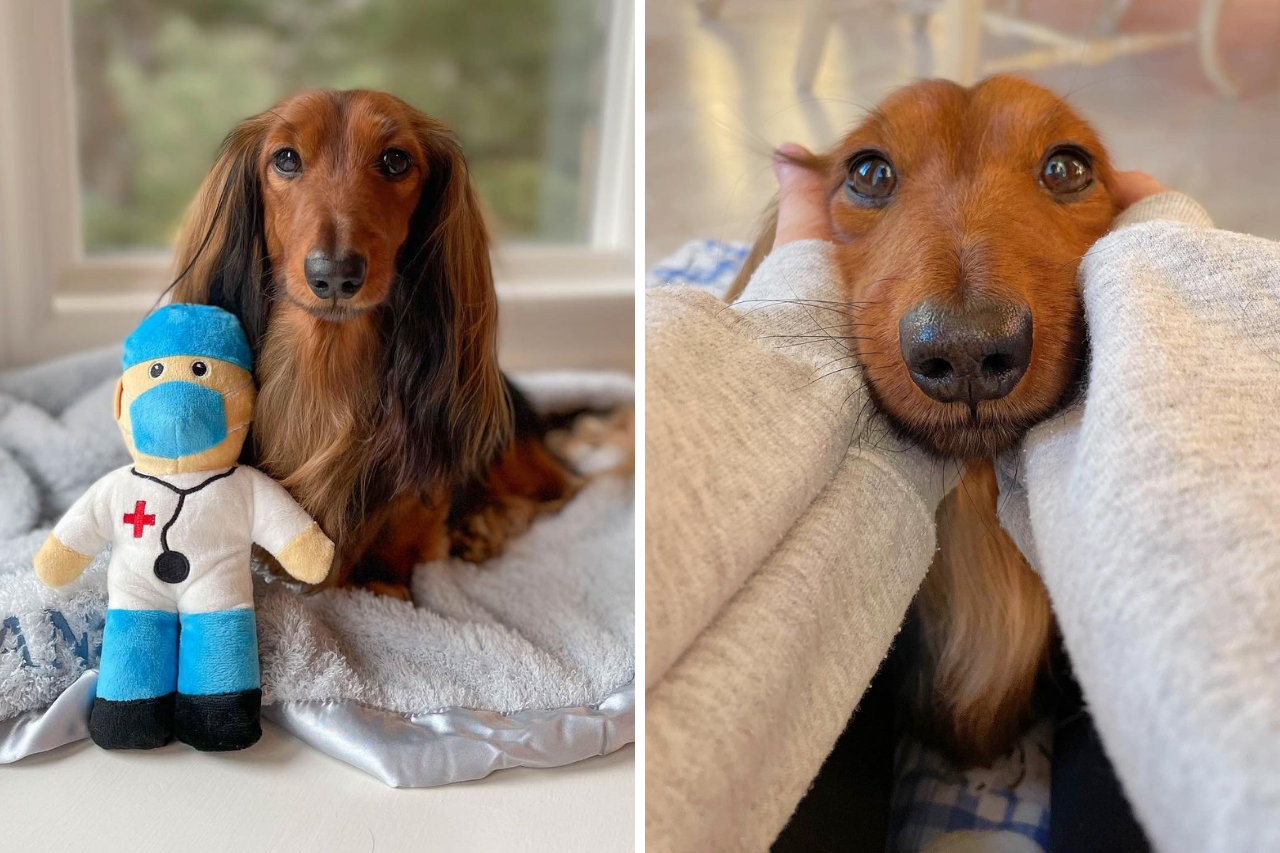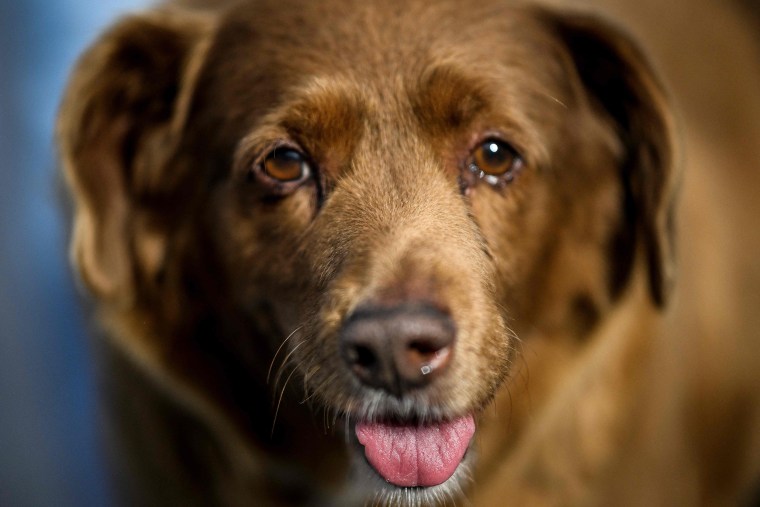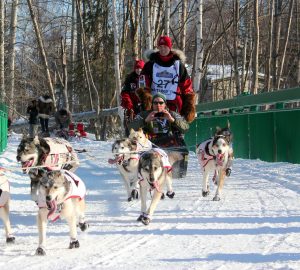
[ad_1]
February 28, 2022

In early January 2022, we (Steph and Mike) skilled what most dachshund house owners dread taking place. Our long-haired “tweenie” dachshund, Django, underwent spinal surgical procedure for Intervertebral Disc Disease (IVDD).
About one week earlier than surgical procedure, Django had what appeared like a minor again damage. One afternoon we seen he was instantly shaking, barely wobbly on his again legs, and clearly in discomfort. Django merely wasn’t his blissful and energetic self. After we sat on the ground with Django, he would tuck his head between our legs or conceal his head in our arms—signs of pain and discomfort in dogs.
Mike and I took Django to an emergency vet and canine neurologist who instantly identified Django with minor IVDD and put him on treatment and strict crate relaxation. Django appeared to enhance actually properly all through the subsequent few days, however he took an surprising flip for the more serious one week later; his ache had clearly returned and his again legs stopped functioning correctly. Inside minutes, it grew to become clear that Django had misplaced nearly all perform in his again legs and was now partially paralyzed. Recognizing the sudden severity of Django’s IVDD, Mike and I took motion instantly.
Django had IVDD surgical procedure on January tenth, roughly 48 hours after he misplaced perform in his again legs, to take away the entire disc materials in his spinal canal which was inflicting him ache and partial paralysis. As of writing (March 2022), Django is fortunately recovering properly, albeit slowly. He lastly began getting extra feeling and performance in his again legs about 3-4 weeks after surgical procedure and is now beginning to use them once more! His again legs stay wobbly and weak, however we and Django’s neurologist proceed to count on Django to see a full restoration over time.
On this DJANGO Dog Blog article, we tackle what to do for those who suspect your canine is affected by IVDD. We cowl what steps it is best to instantly take in case your canine has signs of IVDD, clarify what IVDD is, and in addition tackle further regularly requested questions on Intervertebral Disc Illness in canine.
To be clear, we (Steph and Mike) are not licensed veterinarians. We’re loving canine house owners who’ve not too long ago skilled IVDD with our dachshund Django. Please seek the advice of your common vet or a canine neurologist instantly for those who suppose your sausage canine is affected by IVDD.
In case your dachshund’s entrance legs are usually not working and/or he can not transfer his neck, he most likely has a neck or cervical damage. If your canine can not transfer his again legs, he almost certainly has a problem with one of many 20 vertebrae in his chest or decrease again. Each of those occasion are indicators of extreme Intervertebral Disk Disease (IVDD) and have to be taken very critically. In some circumstances, canine turn into weak or paralyzed in all 4 limbs (often known as tetraparesis).
In case your wiener canine is yelping in ache, shaking, strolling like he’s drunk, or scuffing his toes, he could have a gentle case of IVDD. As talked about above, our dachshund Django initially confirmed gentle signs of IVDD. He was clearly in ache and was wobbly on his legs, however he was nonetheless in a position to transfer freely and nonetheless had perform in his legs. Primarily based on these signs and a neurological examination, Django’s canine neurologist identified him with gentle IVDD and put him on strict crate relaxation. When Django later misplaced perform in again legs, we realized his IVDD case was very extreme.
Whether or not your canine’s IVDD is gentle or extreme, you have to act as rapidly as attainable. It may be troublesome to discern how critical your canine’s case is—principally as a result of our four-legged household can not inform us with phrases how dangerous they really feel. Regardless, for those who suspect your canine has IVDD, take motion instantly. Not addressing IVDD may end up in worsening signs (ache, weak point, immobility), additional harm to the spinal twine, and everlasting paralysis.
IMMEDIATELY CRATE YOUR DOG.
To stop your dachshund’s signs and damage from getting worse, instantly restrict his motion through strict crate relaxation. Do not let your canine proceed to stroll or run round the home as he can additional damage himself and do irreparable harm to his spinal twine.
Use warning: your sausage canine could preserve attempting to rise up, “escape” his crate, and even chunk you as a result of he’s in lots of ache. The most effective factor you are able to do for him proper now could be utterly restrict his motion by placing him in a crate.
In case you suspect your canine has a cervical/neck damage, attempt to preserve his head as nonetheless as attainable.
If you do not have a crate, contemplate wrapping your canine in a blanket or towel and holding him intently to your physique so he can not wriggle, squirm, and injure himself additional. When holding your dachshund, the physique must be horizontal and parallel to the ground, and it is best to all the time be sure that to totally assist the butt and again legs with your arms.
CONTACT YOUR VETERINARIAN.
Name your veterinarian instantly and ask them what it is best to do. If it’s a vacation, the weekend, or after enterprise hours, take your dachshund to an emergency veterinary clinic. Ask your vet and/or the emergency veterinary clinic to advocate a canine neurologist, if one isn’t on employees already, and make an appointment with this new specialist.
Most out-of-hours companies are costlier than routine annual veterinary care. In case you can not afford emergency care or there isn’t a clinic close to you, prepare an appointment along with your common veterinarian as quickly as attainable. Subsequent, put your dachshund on strict crate relaxation. This implies he’s solely allowed out of his crate for potty breaks and veterinary appointments.
INFORMATION FOR YOUR VETERINARIAN OR CANINE NEUROLOGIST
While you see your common/emergency veterinarian or canine neurologist, you’ll want to inform them:
- Whether or not your dachshund’s entrance or again legs are paralyzed
- When your sausage canine began having signs
- How your wiener canine was injured (if identified)
- What his signs are and why you suppose he might need IVDD
- How he acted and what you probably did (e.g., crate relaxation, ache medicines, and so on.) after you first seen his ache.
LEARN ABOUT IVDD.
As a result of many veterinarians are generalists, they might not know lots about IVDD. Sitting within the ready room? Or ready to schedule an appointment along with your common vet? Learn more about intervertebral disc disease in dogs here.
Moreover, search a second opinion in case you are not proud of what your veterinarian is aware of about canine IVDD and/or for those who disagree with their analysis. The most effective factor you are able to do proper now could be discover a respected veterinarian or canine neurologist who has expertise diagnosing and treating canine with IVDD.
IVDD is a genetic illness that impacts the shock-absorbing cushions (intervertebral discs) between the bones (vertebrae) in your canine’s backbone.
The backbone is made up of particular person vertebrae bones. Canines have 30 vertebrae working from the neck to the tailbone. All canines have 7 cervical vertebrae (neck), 13 thoracic vertebrae (chest), 7 lumbar vertebrae (decrease again), and three sacral vertebrae (pelvic). Click here for an illustration of a dog’s 30 vertebrae.
The vertebrae between the neck (cervical) and the decrease again (lumbar) have smooth cushions between them known as intervertebral discs. Intervertebral discs have smooth gel-like facilities and thick outer layers. They’re like smooth and squishy jelly donuts. When their fluid leaks into your pup’s spinal twine house, it places stress on his nerves. This may trigger ache, weak point, and even entrance or again leg paralysis.
We offer a extra detailed overview and explanation of IVDD in dogs in this comprehensive DJANGO Dog Blog article.
THE 5 STAGES OF INTERVERTEBRAL DISK DISEASE
Intervertebral disc illness has 5 completely different phases.
- Stage 1: Your dachshund has gentle again or neck ache that self-corrects in 3 days.
- Stage 2: Your sausage canine has moderate-to-severe ache in his neck or again. When he walks, he drags the tops of his paws throughout the bottom. He additionally has muscle weak point and walks like he’s drunk.
- Stage 3: Whereas your dachshund can transfer his legs, he can’t stand and stroll on his personal.
- Stage 4 (Django’s analysis): Your wiener canine can’t transfer his entrance or again legs, however he can nonetheless really feel his toes once they’re pinched.
- Stage 5: He’s utterly paralyzed and may’t really feel any ache.
“WILL MY DACHSHUND EVENTUALLY DEVELOP IVDD?”
All canine breeds can have a bulging, herniated, ruptured, or slipped disk. However the situation is commonest in chondrodystrophic breeds like dachshunds, English bulldogs, and Pembroke Welsh corgis. Chondrodystrophic breeds have brief legs and lengthy backs.
When you’ve got a sausage canine, this can be very essential to pay attention to IVDD. Roughly 1 in each 4 wiener canine will develop this genetic illness of their lifetime. Dachshunds are 10-12 times extra prone to endure from IVDD than different chondrodystrophic canine breeds. Clean-haired sausage canine are 4.2 instances extra prone to get IVDD than wire-haired or long-haired dachshunds. Spayed female and overweight doxies are additionally rather more vulnerable to IVDD.
With these scary statistics in thoughts, it is very important perceive that IVDD is usually attributable to sudden trauma (i.e., climbing stairs or leaping off furnishings and touchdown incorrectly). Sadly, IVDD will also be genetic.
With our sausage canine Django, no occasion or trauma that we’re conscious of brought on his damage. One Saturday morning Django was utterly high-quality, and later that afternoon he was visibly in ache. He didn’t fall off of a mattress, leap off of a settee “improper”, and even climb a flight of stairs (we have pet gates that stop him from doing stairs in our dwelling). After we requested Django’s neurologist how he may have gotten damage, her reply was clear and easy: genetics.
Dachshunds are most in danger for IVDD between ages 3 and 6. They’re notably liable to IVDD as a result of they’re 50 instances extra prone to have a dwarfism gene mutation known as FGF4-12.
In case your dachshund’s IVDD is gentle, your vet will doubtless advocate anti-inflammatories, ache drugs, and strict crate relaxation. This occurred to Django in October 2020. He had a gentle again damage, and we put him on crate relaxation for 4-6 weeks after taking him to a neurologist. We solely let Django out of his crate for potty breaks and to cuddle, and Django happily had a full restoration from that individual damage.
NEUROLOGICAL EXAM
Your vet or neurologist will first carry out a bodily and neurological examination to find out if IVDD is the almost certainly analysis.
After we introduced Django to the emergency animal hospital after he misplaced perform in his again legs, Django’s neurologist examined the reflexes in every of his paws to see if there was a delay in response as a consequence of spinal twine compression and/or harm. The neurologist additionally pinched Django’s toes to see if he nonetheless felt ache. With a comparatively fast however exact bodily examination, Django’s neurologist was in a position to clearly determine his signs as IVDD associated and analysis the severity of his IVDD as stage 4.
This examination occurred on a Sunday afternoon. Given Django’s extreme situation, he was admitted to the hospital instantly after his bodily examination on Sunday, and he had an MRI (extra on this beneath) scheduled for very first thing Monday morning. Surgical procedure finally adopted Django’s MRI on Monday.
MYELOGRAMS
Your veterinarian could carry out a take a look at known as a myelogram. As soon as your canine is put beneath anesthesia, a particular dye is injected by his spinal twine to assist it present up on an x-ray.
Myelograms can vary in value from $600 and $1,750, relying on the place you might be situated geographically and what kind of facility performs the take a look at. A small proportion of sausage canine are vulnerable to “seizure-like” exercise after they’re injected with dye, however they get better after they’re given Valium (diazepam).
MAGNETIC RESONANCE IMAGING (MRI)
As a result of 45% of dachshunds are identified with IVDD utilizing magnetic resonance imaging (MRI), your vet will most likely order one instantly, particularly if the IVDD case is extreme (phases 3, 4, or 5).
Django misplaced perform in his again legs on a Saturday afternoon, and he had an MRI very first thing Monday morning. The MRI helped Django’s neurologist find the precise intervertebral disc in query and ensure that he urgently wanted surgical procedure that very same day.
Roughly 65% of “slipped discs” are within the mid-back (Django’s analysis) whereas 18% occur within the neck.
Canine MRIs can price as a lot as USD 1,500 to three,000 in america. Costs will differ primarily based on a number of components together with your geographic space. As a reference, we presently stay in New Jersey, and Django’s MRI price $2,200.
The price of IVDD surgical procedure is predicated on a number of components, together with the world you reside in, what a part of your canine’s spinal twine is injured, and the complexity of surgical procedure. The price of your canine’s IVDD operation will doubtless price from USD 3,000 to five,000.
As a reference, we stay in New Jersey (simply exterior of Philadelphia), and Django’s IVDD surgical procedure alone was USD $4,700. Django’s surgical procedure was considerably normal and lasted roughly 90 minutes from begin to end. He had a hemilaminectomy process to take away herniated disc materials from his spinal canal on the T12-13 location. Django’s neurologist mentioned the surgical price would have been increased if Django had 2 impacted places that wanted operation.
Take into account that your complete IVDD invoice will embrace each surgical and non-surgical objects associated to your canine’s care and hospital keep. The price of neurological exams, imaging scans, anesthesia, ache killers and post-op drugs, the size of your canine’s hospital keep—all of these things will doubtless be placed on one bill and billed concurrently. In truth, most animal hospitals that carry out IVDD surgical procedure would require that you simply pay a important deposit upfront, i.e. 30% of your canine’s complete anticipated or most invoice.
When all IVDD surgical and non-surgical prices are accounted for, the overall invoice can vary wherever from USD 6,000 to 12,000. Our remaining hospital invoice was $8,600.
Most sausage canine with gentle IVDD absolutely get better after 4-6 weeks of strict crate relaxation.
Dachshunds which have very critical IVDD (i.e., the place they’re partially paralyzed like Django) want a right away analysis, emergency surgical procedure, and correct post-surgery care. Sadly, some canine by no means absolutely regain management of their limbs, however this final result is very uncommon. Our neurologist particularly mentioned 90-95% of canine like Django are in a position to stroll once more inside 4-6 weeks and see a full restoration in 3-6 months. This signifies that with correct therapy and care, your dachshund will very doubtless stay a cheerful, regular, and lively life after the IVDD analysis.
Questions? Feedback?
Go away a query or inform us about your individual IVDD experiences within the feedback beneath. Observe Django’s IVDD journey on Instagram and Facebook.
Extra Sources
Leave a comment
Comments will be approved before showing up.
[ad_2]
Source link







